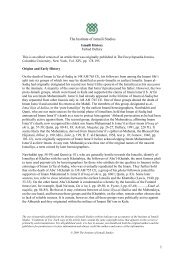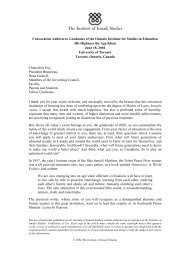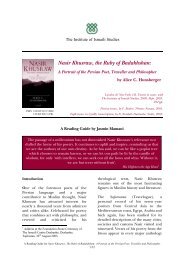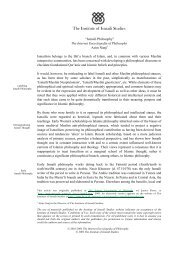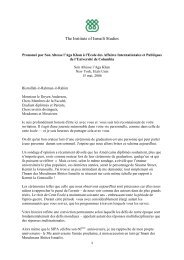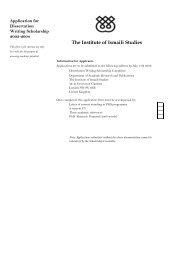The Institute of Ismaili Studies
The Institute of Ismaili Studies
The Institute of Ismaili Studies
You also want an ePaper? Increase the reach of your titles
YUMPU automatically turns print PDFs into web optimized ePapers that Google loves.
<strong>The</strong> <strong>Institute</strong> <strong>of</strong> <strong>Ismaili</strong> <strong>Studies</strong><br />
Title: Shabistari, Mahmud<br />
Author: Leonard Lewisohn<br />
Source: <strong>The</strong> Biographical Encyclopaedia <strong>of</strong> Islamic Philosophy, 15 July 2006, pp.<br />
260-262<br />
Copyright permission has been sought from the aforementioned publisher.<br />
<strong>The</strong> use <strong>of</strong> materials published on the <strong>Institute</strong> <strong>of</strong> <strong>Ismaili</strong> <strong>Studies</strong> website indicates an acceptance <strong>of</strong> the<br />
<strong>Institute</strong> <strong>of</strong> <strong>Ismaili</strong> <strong>Studies</strong>’ Conditions <strong>of</strong> Use. Each copy <strong>of</strong> the article must contain the same copyright<br />
notice that appears on the screen or printed by each transmission. For all published work, it is best to<br />
assume you should ask both the original authors and the publishers for permission to (re)use information<br />
and always credit the authors and source <strong>of</strong> the information.<br />
© 2010 <strong>The</strong> <strong>Institute</strong> <strong>of</strong> <strong>Ismaili</strong> <strong>Studies</strong>
<strong>The</strong> <strong>Institute</strong> <strong>of</strong> <strong>Ismaili</strong> <strong>Studies</strong><br />
Shabistari, Mahmud<br />
Leonard Lewisohn<br />
(This article was originally published by Thoemmes Continuum in <strong>The</strong> Biographical Encyclopaedia<br />
<strong>of</strong> Islamic Philosophy, 15 July 2006, pp. 260-262.)<br />
<strong>The</strong> celebrated Persian Sufi poet, Sa‘d al-Din Mahmud Ibn ‘Abd al-Karim Yahya Shabistari (d. after<br />
1340 CE) was born in the last half <strong>of</strong> the thirteenth century at Shabistar, a small village northwest <strong>of</strong><br />
Tabriz, located a few miles inland from Lake Urumiya in present-day province <strong>of</strong> eastern<br />
Adharbayjan in Iran. Almost nothing is known <strong>of</strong> his life, wife, children or family ancestors.<br />
According to his own admission, he spent many years <strong>of</strong> his life travelling through Egypt, Turkey and<br />
Arabia in pursuit <strong>of</strong> knowledge. However, from his frequent references to other poets and mystics <strong>of</strong><br />
Tabriz in his Sa‘adat-nama (Book <strong>of</strong> Felicity), it is evident that most <strong>of</strong> his life was passed in Tabriz,<br />
one <strong>of</strong> the main centres <strong>of</strong> Persian literary culture and mysticism in Mongol Persia.<br />
Author <strong>of</strong> two books <strong>of</strong> mystical poetry and a single theosophical treatise, Shabistari is famed mainly<br />
for his 1000-line Sufi poem Gulshan-i raz (Garden <strong>of</strong> Mystery), which he composed in December<br />
1317 in rhyming couplets amounting to about one thousand distiches. This poem was written in<br />
response to seventeen queries concerning various intricacies <strong>of</strong> Sufi metaphysics posed to the Sufi<br />
masters <strong>of</strong> Adharbayjan by another great Sufi <strong>of</strong> his day, Rukn al-Din Husayni Harawi (d. 718 AH /<br />
1318 CE).<br />
Composed in a highly symbolic language, and drawing upon the lexicon <strong>of</strong> several centuries <strong>of</strong><br />
Persian symbolic poetry, the Garden <strong>of</strong> Mystery sets forth the dicta <strong>of</strong> the Sufis on a variety <strong>of</strong> themes<br />
such as ‘Thought’ (fikr), ‘the Soul’ (nafs), ‘Knowledge’ (ma‘rifat), Multiplicity and Unity <strong>of</strong> the<br />
Realms <strong>of</strong> Being, Hierarchical Levels <strong>of</strong> Being, the Spiritual Voyage (sayr) and Methodical<br />
Progression on the Sufi Path (suluk), nearness (qurb) and distance from God (bu‘d), and the evolution<br />
<strong>of</strong> the soul. It was one <strong>of</strong> the most frequently commented upon works in all <strong>of</strong> Persian Sufi literature;<br />
by the middle <strong>of</strong> the sixteenth century close to thirty commentaries had been written upon it by a<br />
number <strong>of</strong> Persian mystics, both renowned and obscure, the most important <strong>of</strong> these being the Mafatih<br />
al-i’jaz fi sharh-i Gulshan-i raz by Muhammad Lahiji (d. 1507 CE).<br />
<strong>The</strong> poem was first brought to the attention <strong>of</strong> Western Orientalists by the French travellers Chardin<br />
and Bernier, who visited Persia in the seventeenth century and reported the poem’s reputation in<br />
learned circles there as a ‘somme théologique’. A précis <strong>of</strong> the poem was subsequently translated into<br />
Latin in 1821 by Tholuck in his Sufismus, later to be followed in 1825 by his translation into German<br />
<strong>of</strong> a third <strong>of</strong> the poem in his ‘Bluthensammlung aus der Morgenlandischen Mystik’. <strong>The</strong> Gulshan-i<br />
raz entered into the mainstream <strong>of</strong> Western Islamic studies when the Persian text was published in<br />
1838 with a German verse translation by J. von Hammer-Purgstall. In 1880, this text was revised and<br />
collated with several manuscripts omitted by Hammer and republished in England accompanied by an<br />
English translation by E.H. Whinfield. It has since been translated into English several times,<br />
although none <strong>of</strong> these translations have added anything substantial to Whinfield’s rendition.<br />
Shabistari’s only other Sufi poetic epic was the Sa‘adat-nama (Book <strong>of</strong> Felicity), a work largely<br />
devoted to the deliberate poeticisation <strong>of</strong> subjects which properly belong to the science <strong>of</strong> kalam,<br />
Islamic philosophical theology. He composed a single theosophical treatise, the Haqq al-yaqin,<br />
divided into eight chapters (abwab, ‘Gates’, corresponding to the eight Gates <strong>of</strong> Paradise), each <strong>of</strong><br />
which is between two to five pages in length. <strong>The</strong>se ‘Gates’, in turn, are subdivided into discrete<br />
paragraphs with a separate lemma heading the text. Some <strong>of</strong> the lemmata typically featured include<br />
Reality (haqiqat) - An Illustration (tamthil) - Nota Bene (tabura) - Corollary (far‘) - Inference (natija)<br />
- A Subtle Mystery (sirr-i nazuk) -Natural Consequence (lazima) - Beneficial Proposition (fayida) -<br />
Subtlety (daqiqa). <strong>The</strong> book is thus subdivided into small passages, some <strong>of</strong> which are only a short<br />
paragraph in size, expounding a philosophical point or metaphysical truth, followed by a citation from<br />
…Please see copyright restrictions on page 1<br />
2
<strong>The</strong> <strong>Institute</strong> <strong>of</strong> <strong>Ismaili</strong> <strong>Studies</strong><br />
the Qur’an. Neither the Sa‘adat-nama nor the Haqq al-yaqin have been translated into any European<br />
language.<br />
A follower <strong>of</strong> Ibn al-‘Arabi, all the poetic and prose work <strong>of</strong> Shabistari shows a peerless flair for<br />
metaphysical penetration combined with an aphoristic skill in synthesising intricate dilemmas <strong>of</strong><br />
Islamic theological and theosophical thought. He is unrivalled by any other medieval Persian Sufi<br />
poet in brevity <strong>of</strong> output and pr<strong>of</strong>undity <strong>of</strong> content. While in the Garden <strong>of</strong> Mystery Shabistari<br />
embraces without reservation the teachings <strong>of</strong> Ibn al-‘Arabi, in the Sa‘adat-nama he is more cautious<br />
and raises certain objections to him, relying mainly on al-Ghazali (d. 1111 CE). His religious<br />
orientation (as well as the outlook <strong>of</strong> some <strong>of</strong> his contemporary Kubrawi masters – Nur al-Din<br />
Isfarayini, Semnani and Maghribi (d. 810/1408) – reflected that <strong>of</strong> Kubrawi Sufi Order, to which he<br />
probably belonged. He adhered to a philosophical tradition followed by Sufis, theologians and<br />
philosophers alike; a tradition which emphasises that knowledge can be attained by one or a<br />
combination <strong>of</strong> three means: (1) revelation (wahy), (2) reason (‘aql) and (3) kashf (unveiling),<br />
corresponding to the methods pursued respectively by the theologians, philosophers and Sufis. In the<br />
works <strong>of</strong> later Persian mystical philosophers ranging from the fourteenth to the twentieth century,<br />
such as Sa’in al-Din Turkah (Ibn Turka) Isfahani (d. c. 830 / 1427 ), Mulla Sadra (d. 1050 / 1640),<br />
‘Abd al-Razzaq Lahiji (d. 1072 / 1661-2), Mulla ‘Abdullah Zunuzi (d. 1257 / 1841 ), Hadi Sabzwari<br />
(d. 1295/1878), verses from Shabistari’s Gulshan-i raz are frequently cited to illustrate metaphysical<br />
concepts and encapsulate their views on the subtler points <strong>of</strong> ontology, ethics or epistemology.<br />
Bibliography<br />
Gulshan-i raz, ed. S. Muwahhid, Majmu’a-i athar-i Shaykh Mahmud Shabistari, Tehran: Kitabkhanai<br />
tahuri, 1986.<br />
Further Reading<br />
Izutsu, Toshiko, ‘<strong>The</strong> Basic Structure <strong>of</strong> Metaphysical Thinking in Islam’, in his Creation and the<br />
Timeless Order <strong>of</strong> Things: Essays in Islamic Mystical Philosophy, Ashland, OR: White Cloud Press,<br />
1994, pp. 1-37.<br />
Lewisohn, Leonard, Beyond Faith and Infidelity: the Sufi Poetry and Teachings <strong>of</strong> Mahmud<br />
Shabistari, London: Curzon, 1995.<br />
Vitray-Meyerovitch, Eva de (trans.), La Roseraie du Mystere (suivi du Commentaire de Lahiji), Paris:<br />
Sindbad, 1991.<br />
…Please see copyright restrictions on page 1<br />
3






